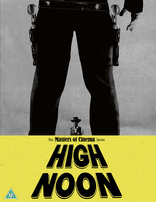High Noon Blu-ray Movie
HomeHigh Noon Blu-ray Movie 
Masters of Cinema | Limited EditionEureka Entertainment | 1952 | 85 min | Rated BBFC: U | Sep 16, 2019
Movie rating
8.2 | / 10 |
Blu-ray rating
| Users | 0.0 | |
| Reviewer | 5.0 | |
| Overall | 5.0 |
Overview
High Noon (1952)
A retired Marshal must defend his town from a revengeful villain.
Starring: Gary Cooper, Thomas Mitchell (I), Lloyd Bridges, Katy Jurado, Grace KellyDirector: Fred Zinnemann
| Drama | Uncertain |
| Western | Uncertain |
| Thriller | Uncertain |
Specifications
Video
Video codec: MPEG-4 AVC
Video resolution: 1080p
Aspect ratio: 1.37:1
Original aspect ratio: 1.37:1
Audio
English: LPCM 2.0 Mono (48kHz, 24-bit)
Subtitles
English SDH
Discs
Blu-ray Disc
Single disc (1 BD)
Playback
Region B (locked)
Review
Rating summary
| Movie | 5.0 | |
| Video | 5.0 | |
| Audio | 5.0 | |
| Extras | 5.0 | |
| Overall | 5.0 |
High Noon Blu-ray Movie Review
Reviewed by Dr. Svet Atanasov August 14, 2019Fred Zinnemann's "High Noon" (1952) arrives on Blu-ray courtesy of Eureka Entertainment. The supplemental features on the disc include an original trailer for the film; archival audio interview with Carl Foreman; archival documentary with critic Leonard Maltin; new video interview with critic and author Neil Sinyard; and more. Also included with this release is a 100-page collector's book featuring new writing on the film, archival articles and materials relating to the film, and more. In English, with optional English SDH subtitles for the main feature. Region-B "locked".
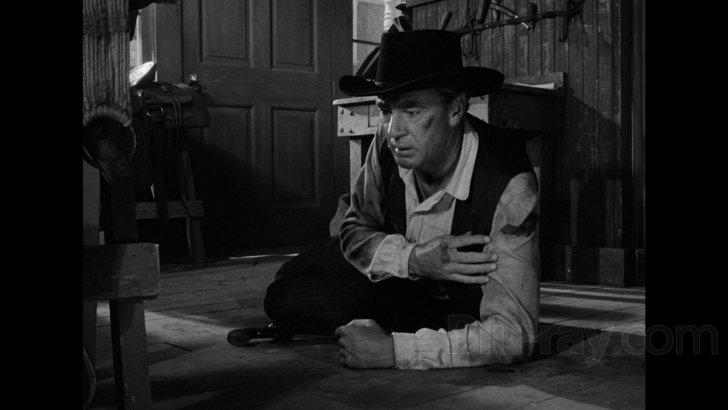
Fred Zinnemann's western High Noon has been discussed so much during the years that at this point, there is nothing one can write about it that has not already been written by someone else. One can probably only add that its ‘classic’ status is certainly deserved.
Sheriff Will Kaine (Gary Cooper) has found the perfect woman (Grace Kelly) to settle down with and is now ready to retire. She has asked him to do so, and he has given her his word that as soon as they are pronounced husband and wife, he will take off his badge and call it quits.
But on his final day on the job, Kaine is told that his replacement will be late and that the notorious gunslinger Frank Miller (Ian MacDonald) is coming back to town. This is bad news for Kaine because a few years ago, when he cleaned up the town, he placed Miller behind bars, and he vowed to put a bullet in his head.
Miller is due to arrive on the noon train. He will be greeted by his three best men (one of them played by a very young-looking Lee Van Cleef), and then together they will go looking for Kaine.
The local residents urge Kaine to rush and leave town so that he can avoid confrontation with Miller, but he decides to stay and deal with the gunslinger once and for all. Shortly after, his wife abandons him, and then the town’s residents agree that it will be in their best interest to distance themselves and do the same.
The film has a very simple message: It is worth fighting and even dying for what is right. But during the years, there have been a number of very political interpretations of it that have been used to reframe it in different ways. One of these interpretations suggests that Miller portrayed the infamous Senator Joseph McCarthy and his gang as the HUAC (the House Un-American Activities Committee), while Kaine portrayed the film’s writer, Carl Foreman, who was a member of the Communist Party and was called before HUAC during the early 1950s. So the environment in which the clash between Kaine and Miller occurs apparently imitated the polarized and paranoid environment in which Foreman lived. There is another popular interpretation which suggests that the odd conflict between Kaine and the town’s residents reflected the division between people like Foreman and other communists who abandoned them and later on became informers and witnesses for McCarthy’s people. So in this interpretation, the focus of attention is actually on the erosion of trust between the communists as well as their bitter disillusionment.
It is also worth mentioning that during the Cold War era, the film resonated very differently with folks living behind the Iron Curtain. Kaine was seen as a promoter of the strength of American individualism, and his stance was interpreted as a veiled denunciation of the mass fear and hypocrisy that kept the communists and their lackeys in power for decades. So in this case, the film turned out to be quite effective as a pro-American piece with specific and surprisingly relevant political points.
Ultimately, however, the film’s strength isn’t in its ability to inspire political debates. Its technical qualities -- from the brilliant decision to shoot in real time to the careful framing choices to the great management of Dimitri Tiomkin’s score and the manner in which it enhances the tension and drama – are undeniably excellent.
The film is loosely based on John W. Cunningham's story "The Tin Star". According to various reports, however, producer Stanley Kramer bought the rights to the story after he discovered that Foreman’s script actually had plenty of similarities with the original story.
High Noon Blu-ray Movie, Video Quality 
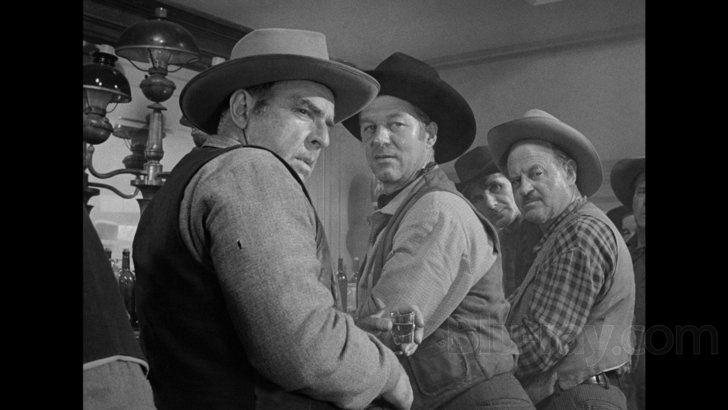
Presented in its original aspect ratio of 1.37:1, encoded with MPEG-4 AVC and granted a 1080p transfer, Fred Zinnemann's High Noon arrives on Blu-ray courtesy of Eureka Entertainment.
The release is sourced from the very beautiful 4K restoration that Olive Films used to produce this release of High Noon for the U.S. market. Quite predictably, once again, I have nothing but great things to say about the quality of the work that was done to make the film look as healthy and lush as it does. Delineation, depth, and fluidity are all much better than those of older releases sourced from older masters. The grading is also convincing, though I guess that in native 4K, some visuals will reveal better nuances. (Most likely in areas where the blacks can now appear a bit stronger). The overall image stability is excellent. Really, folks, if you like this film, the 4K restoration is the only way to revisit it in the future. (Note: This is a Region-B "locked" Blu-ray release. Therefore, you must have a native Region-B or Region-Free player in order to access its content).
High Noon Blu-ray Movie, Audio Quality 
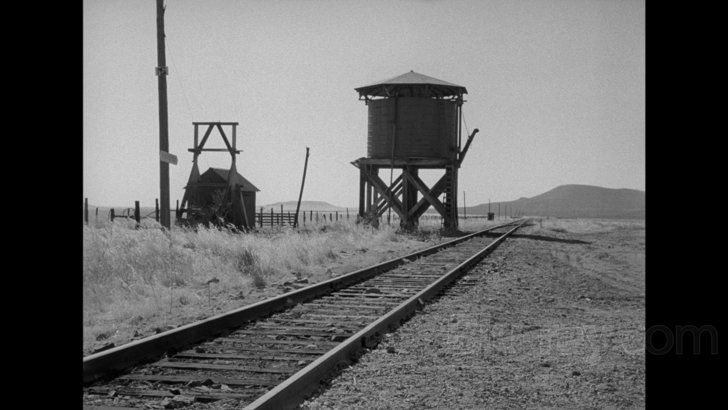
There is only one standard audio track on this Blu-ray release: English LPCM 2.0. (Mono). Optional English SDH subtitles are provided for the main feature.
The audio is clean, stable, and free of conventional age-related anomalies. Even if you turn up the volume quite a bit, you will not detect any issues that could negatively affect your viewing experience. As is always the case with older films, however, you should expect a more modest range of dynamic nuances.
High Noon Blu-ray Movie, Special Features and Extras 
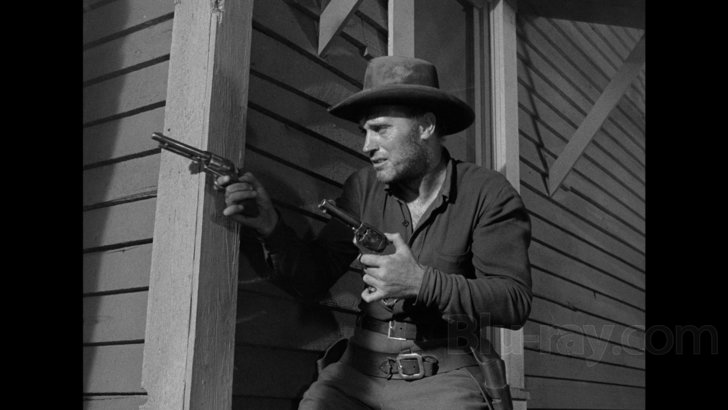
- Trailer - original trailer for High Noon. In English, not subtitled. (3 min, 1080p).
- Interview with Neil Sinyard - in this new video interview, critic and author Neil Sinyard (Fred Zinnemann: Films of Character and Conscience discusses the production history of High Noon as well as some popular myths about the nature of its story and what it supposedly symbolizes. In English, not subtitled. (30 min, 1080p).
- Carl Foreman Interview - this archival audio interview with Carl Foreman was recorded at the National Film Theatre in London in 1969. It covers a wide range of topics, from Foreman's personal life to his contributions to various films. In English, not subtitled.
- Inside "High Noon' - this archival documentary focuses on the production history of High Noon and its image as one of America's greatest westerns. Included in it are clips from archival interviews with Maria Cooper Janis, Stephen Prince (Virginia Tech), Tim Zinnemann (son of Fred Zinnemann), and Bill Clinton, amongst others. Narrated by Frank Langella. Written and directed by John Mulholland. In English, not subtitled. (50 min, 1080i).
- The Making of 'High Noon' (1992) - in this archival documentary, critic Leonard Maltin takes a closer look at High Noon and explains why it is one of the greatest westerns ever made. In English, not subtitled. (23 min, 1080i).
- Behind 'High Noon' (2002) - this featurette was produced for the film's 50th anniversary in 2002. It features interviews with Maria Cooper, Jonathan Foreman, Tim Zinnemann, and Prince Albert of Monaco. In English, not subtitled. (10 min, 1080i).
- Audio Commentary One - an exclusive new audio commentary by historian Glenn Frankel.
- Audio Commentary Two - an exclusive new audio commentary by critic Stephen Prince.
- Book - 100-page collector's book featuring new writing on the film; the original short story The Tin Star by John W. Cunningham; excerpts from writings and interviews with director Fred Zinnemann; archival articles and materials relating to the film.
High Noon Blu-ray Movie, Overall Score and Recommendation 
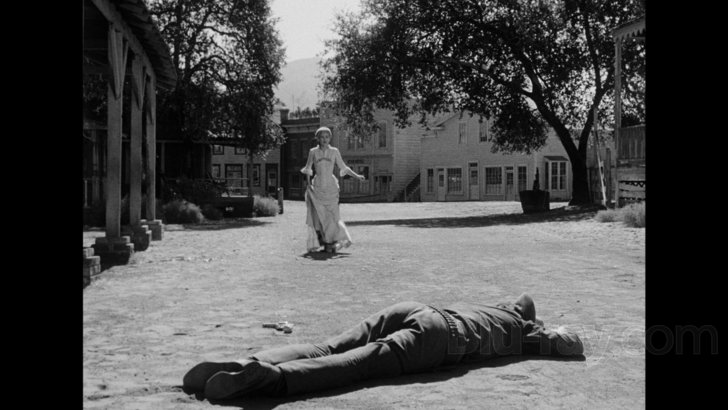
There have been some drastically different interpretations of the political overtones in Fred Zinnemann's High Noon, but I find them largely irrelevant now. The film is rightfully placed amongst the all-time greatest classics of the western genre because of its technical qualities, which are quite simply brilliant. This upcoming Blu-ray release of High Noon is sourced from the excellent 4K restoration of the film that a couple of years ago Olive Films introduced in the United States with their Signature Edition Blu-ray. I can't see how a film collection can be complete without High Noon, so if you do not have it yet, now is a good time to order your copy. VERY HIGHLY RECOMMENDED.
Other editions
High Noon: Other Editions
Similar titles
Similar titles you might also like

The Man Who Shot Liberty Valance 4K
1962

Decision at Sundown
Indicator Series
1957

3:10 to Yuma
1957

Ride Lonesome
Indicator Series
1959

My Darling Clementine
Arrow Academy
1946

Unforgiven
1992

Rio Bravo 4K
1959

Winchester '73 4K
1950

A Fistful of Dollars 4K
Per un pugno di dollari | Special Edition
1964

Once Upon a Time in the West
C'era una volta il West
1968

High Plains Drifter
1973

One-Eyed Jacks
Arrow Academy
1961

Shane
Masters of Cinema
1953

The Proposition
Remastered | Limited Edition
2005

The Hired Hand
Arrow Academy
1971

The Searchers
1956

Buchanan Rides Alone
Indicator Series
1958

The Magnificent Seven
1960

The Wild Bunch
1969

For a Few Dollars More 4K
Per qualche dollaro in più | Special Edition
1965
